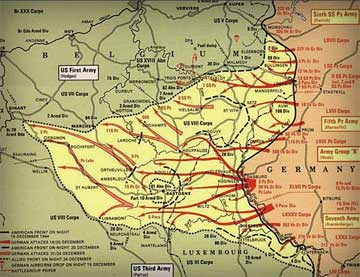Our Stories

The Battle Of Operation Varsity
by Jake Dalton
My outfit went into combat at the Bulge on Christmas Day in 1944 and we continued combat through early February, 1945. From there, we were sent to a tent city outside Nancy, France to prepare for our next assignment where we received new clothes, weapons, and men; we had suffered about 40% casualties in the battle at the Bulge. We figured that our next bout would be a jump since we did a practice jump from C—46 planes (we had used C—47's in all our jumps previously).
Around March 20, 1945, my Battalion S–2 Unit was trucked to a marshaling area some miles away. We were told that we were going to make a jump into Germany and I was given photos and maps showing the planned Drop Zone for our Bn. With this data, I made a sand table to—scale of our Drop Zone, which included all features that should be easily identifiable from the air — the main feature in our area was an east/west power line. The sand table was in a tent large enough to hold a platoon, along with a couple of squads where we could spend a few minutes at the table (the table was on a sheet of plywood). On March 24, 1945, the most memorable day of my life began.
We had a great breakfast and marched, or were trucked, to the airfield in Germany. We helped each other check our equipment and get into our chutes. A lot of the guys showed up with Mohawk haircuts received the night before. We piled into the C–46's — seemed like 12 or 13 on each side of the plane, and around 10am we were off. It was a beautiful warm sunny day with excellent visibility. Sandwiches were passed out to those who could think about eating. As we neared the Rhine River, the jump master gave the orders — stand up, hook up, check equipment, sound—off for equipment check, stand in the door (I think my heart rate increased).
As I stood in the door just behind my Lieutenant, I could see the remains of the Wesel Bridge about a quarter mile to our left (I drove over that bridge in 1974). When we were near the east bank, the anti—aircraft fire began (I know my heart rate increased!). It seemed the plane was jumping up and down and holes started appearing in the fuselage. From what I remembered of the sand table, I figured that we had a few more minutes before we reached our Drop Zone and I was never so glad in my life as when the jump master yelled, “GO.” Even as the propeller blast blew my chute in front of me, I could see shell bursts and hear fragments zinging past me. When my chute was fully open, I just wanted to get on the ground and out of it.
My lieutenant and I landed in a corral and, as I turned to unlatch my chute, I could see 20mm bullets hitting the ground about 6–8 inches from my face. I crawled over to the lieutenant, who was about 5 yards from me and unmoving. He was on his back, covered with blood above his shattered reserve chute. As I said, we were in the open. The nearest cover was a tree or two about 60 feet away. As I started toward the cover, the 20mm rounds stopped. Somebody on our side of the shoot—out got to the gun. I pointed a medic in the direction of my lieutenant, but he didn't make it, my lieutenant was dead.
Back to the beginning, the sand table wasn't much help because we missed our Drop Zone by about 1.5 miles. By the time we got to where we were supposed to be, the British gliders had already landed — some of them still burning. I'll never forget the smell of burning flesh as long as I live.
If you're interested in learning more about this battle, it was named, “Operation Varsity.” It was the last and largest airborne assault during WWII. There were over 1,000 casualties on the first day. A book authored by Stephen Wright, “The Last Drop,” recounts the entire operation.